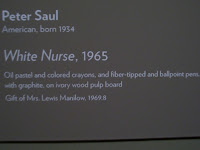On Saturday, October 6th, I visited the Art Institute of Chicago with my Portfolio group to view the exhibits. Afterwards, we were assigned to create a blog post that showcases what we think are the best works.
This piece, Exquisite Corpse, is the one that inspired my blog post from October 23rd. I admire this one greatly because of its pure surrealism, disjointed and disconnected from a coherent reality, hence the reason I was so inspired by it.
This piece, a 1928 collaborative effort by Yves Tanguy, Man Ray, Max Morise, and Andre Benson ; and created with pen, brown ink, graphite, and colored crayons on paper, displays a bizarre-looking figure with an appearance that defies all description, with distored limbs and various objects standing in for limbs.
I think the first most noticeable detail in this piece is the weird contraption in the place where the figure's right arm should be, which gives a very inhuman quality to something that seems inhuman to start with. The next most noticeable detail, I think, is the figure's body, shaped like a human heart, complete with a protruding artery. Finally, one should take notice of the serpentine creature slithering between the figure's legs.
I think the first most noticeable detail in this piece is the weird contraption in the place where the figure's right arm should be, which gives a very inhuman quality to something that seems inhuman to start with. The next most noticeable detail, I think, is the figure's body, shaped like a human heart, complete with a protruding artery. Finally, one should take notice of the serpentine creature slithering between the figure's legs.
Considering this piece is little more than a woman's face made of various objects, I don't have very much to say in terms of Concept and Composition in this case.
I liked this piece, however, because it seemed very unique among the other works that were created with the usual oils and pastels.
This untitled work was created by Francis Picabia in 1920 with the use of various bits and pieces of junk, such as matchsticks, hairpins, coins, and string.
White Nurse, I feel, has a lot of social commentary in it, seemingly speaking out against the Vietnam War ( the army helmets) and the Klu Klux Klan ( the three crucifixes and the title, White Nurse).
Peter Saul created this piece with graphite on ivory wood pulp board, and colored with oil pastel, crayons, and fiber-tipped and ballpoint pens.
I think the first detail that should call people to attention would be, of course, the central figure, since it is the single most noticeable detail in the piece. The second, the gigantic phallic object that trails from from the left side of the canvas to the other, which should stand out with its bright yellow hue. Finally, one should take notice of the duck near the top, which seems almost out of place.
Now, out of the the works of art that I have selected that I consider a true masterpiece, I have chosen Salvador Dali's 1937 oil on canvas piece, Inventions of the Monsters. The reason I think this one is the best out of the others is that Dali's work is widely considered to be the most surreal in the world of art, and, as I have mentioned before, I hold an immense admiration to surrealism. Unlike Exquisite Corpse, however, this piece seems to hold some actual substance to it, as an outcry against war, much like White Nurse. It also seems that Dali is recording a dream in this work, as explained in the art description above.
The piece shows a winged figure wearing a mask, crouched berfore a horse-headed creature rising out of a wooden block, apparently offering it something. While this takes place, various monstrous shapes dance about them in a post-apocalyptic landscape.
The detail I think people should notice first should be the flaming giraffe off to the side, either an animal who has been set about by the monsters with torches, or a monster itself. The second detail, I think, should be the score of horselike creatures, apparently partaking in some sort of demonic ceremony. The final detail people should notice should probably be the ghostly image of a dog, who either looks upon the whole scene in morid curiosity, or is frozen with terror.








No comments:
Post a Comment